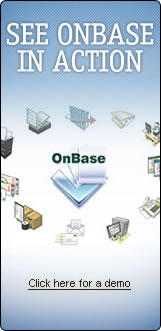
| Sitemap | Login | FAQ's |
|---|






Home > Products> Onbase Product Modules >
Business Process Automation Modules
>
Business Rules Engine
|
|---|
|
Business Rules Engine
The OnBase Business Rules Engine allows organisations to react quickly to changing business conditions, adjusting their approaches to markets or adding new lines of business. The Business Rules Engine is designed to allow managers to create business rules that contain parameterized values. This allows shift supervisors to adjust threshold values as needed to account for dynamic business environments. The OnBase Business Rules Engine is an add-on module for OnBase Workflow . It adds two tiers of client-side configuration privileges, which are assigned by Workflow administrators. The Business Rules Engine configuration interface reduces the need for developing custom solutions using E-Forms and scripting. Because rules can be created and modified client-side, changes do not require restarting clients and disrupting end users. In addition to the control and flexibility the Business Rules Engine adds to Workflow solutions, it simplifies the creation of sophisticated workflows by providing client-side functionality to perform complex calculations and import data from XML documents, external databases and Web services, simplifying development and maintenance. Application The OnBase Business Rules Engine will most benefit organisations that operate within dynamic environments where market or regulatory forces require frequent changes to the business rules that drive its processes. In addition, the flexibility the Business Rules Engine adds to workflows will help organisations that have a need to mitigate risk by being able to quickly alter business rules as part of a contingency planning solution. The Business Rules Engine is beneficial for organisations with complex processes by simplifying the development and maintenance of workflows. A common application of the Business Rules Engine is the adjustment of threshold parameters for authority levels used for document routing. With a simple right-click option in the client, an authorized manager can adjust, for example, the maximum loan amount that different users have authority to approve. An example of a more complex application is an insurance policy renewal life cycle. A typical insurance company can have as many as 90 different evaluation conditions that determine whether a policy is routed to underwriting or rating as the first step of the renewal process. The Business Rules Engine simplifies the creation of the initial set of conditions, and then enables business users to modify the frequently changing conditions and adjust the parameters in real time. Without the Business Rules Engine, an organisation would need to program a custom E-Form and Visual Basic® script (VBScript), which would have taken an additional week of development and testing. Core Features
|
|
|---|

